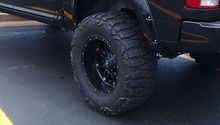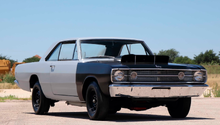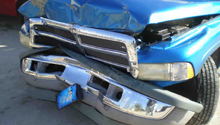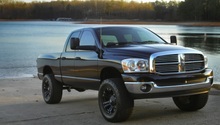Dodge Ram 1994-2001: Will Ford Wheels Fit My Dodge?
Whether you want to install Ford wheels on your Dodge Ram because you like them or because they're cheaper, we have some answers.
This article applies to the Dodge Ram 1500 (1994-2001).
One of the first modifications that owners can to do to personalize their truck is to change the wheels. New wheels can really set your Ram apart from all the other ones on the road. However, it also can get costly when it comes to purchasing a new set. Luckily, used wheels are for sale all over but not all will be listed as being off of a Dodge Ram with the same year range as yours. By branching out and looking for wheels that came off other vehicles, you can widen your search to find the right set of wheels. This article will cover what wheels from a Ford F-150 will fit on your Dodge Ram.
Component Breakdown
Bolt Pattern
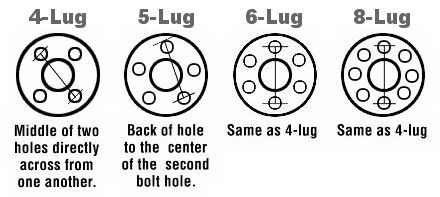
The first step in finding wheels to fit your truck is finding a set with the correct bolt pattern, which is 5x5.5. This means that there are 5 bolt holes on the wheel that are 5.5" apart; refer to Figure 1 above for how the distance between bolt holes is calculated. This bolt pattern is also found on the majority of the F-150s produced starting from 1954 all the way up to 1996. It is also found on all of the Ford Broncos produced.
Offset/Backspacing
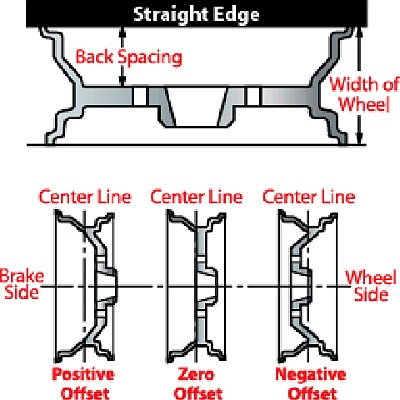
If you've ever searched for wheels online you've probably come across descriptions like; +44mm or 5" of BS. These terms refer to the measuring of wheel offset and wheel backspacing, respectively. Both of these measurements mean the same thing but are reached through different methods.
- Backspacing is calculated as the distance from the back of the wheel face where the studs come through, to the outside edge of the wheel measured in inches. Backspacing is a very easy measurement compared to offset because it isn't dependent on anything else. To give an example; Take two wheels that are both 9" wide. Wheel A has 4.5" of backspacing and wheel B has 6" of backspacing. Wheel A will stick out from the wheel hub approximately 1.5" more than wheel B because of the lower backspacing.

-
Offset is calculated by measuring the distance between the outside wheel flanges to get the inner wheel width, and then dividing by two to get the wheel center line. You then subtract this number from the wheel backspacing and convert to millimetre to get the offset. If the wheel center line length is more than the backspacing, you'll have a positive offset. If the wheel center line is less than the backspacing, you'll have a negative offset. To give an example, Take two wheels that are both 9" wide. Wheel A has an offset of -12mm and wheel B has an offset of +25. Wheel A will stick out from the wheel hub approximately 1.5" more than wheel B because of the negative offset.
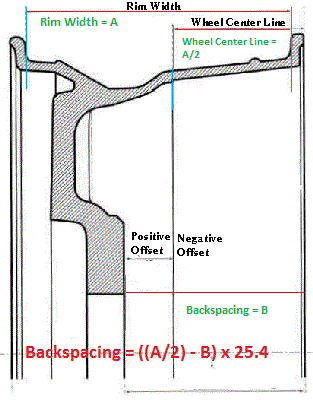
The 94-01 Ram 1500s came out of the factory with wheels between 5-5.5" of backspacing. This means going to a wheel with less backspacing will cause it to stick out further and a wheel with higher backspacing will cause it to tuck in more. Going to an extreme in one direction or the other can cause bad rubbing issues based on tire choice or can cause the wheel to catch on things like the control arms when turning.
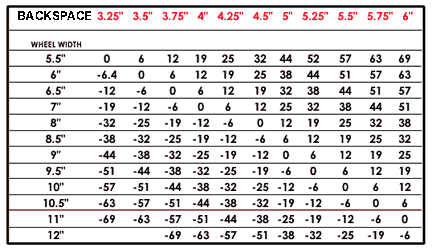
Wheel Diameter

When choosing which wheel diameter you want to run there's a couple of things to keep in mind :
- Technically, the smallest wheel that you can fit is 16" due to the size of the rotors. However, on the 94-99s, you can fit a 15" wheel but it needs to have 3.5" of backspacing or less to clear the rotors. I don't recommend doing this as that low of a backspacing is going to cause a lot of problems with your wheel bearings.
- Increasing wheel diameter increases the overall weight of your wheel/tire combo. There's very few times that this doesn't occur and it normally involves using ultralight racing wheels. To give an example: a 33" tire with a 20" wheel will weigh more than a 33" tire with a 16" wheel. While a 10-15 pound difference may not seem like much, the additional rotating mass will have a negative impact on both fuel economy as well as the power you feel coming from a dead stop.
- Increasing wheel diameter increases the cost of tires. You'd think that a larger wheel means less rubber is used to make the tire so it'd be cheaper, but unfortunately, tire costs increase almost exponentially with every inch of wheel diameter increase.
Related Discussion and Sites
- Wheel Tech - RSRacing.com
- Ram Wheel and Tire FAQ - DodgeForum.com
- 5x5.5 Lug Pattern List - FordTruckClub.net

